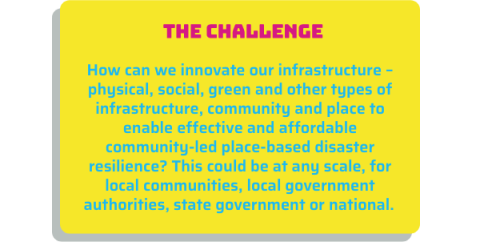


You are invited to livestream this year’s Disaster Challenge Final from Hobart!
The three finalist teams are perfecting their pitches and Natural Hazards Research Australia would love you to join us to hear how these could revolutionise infrastructure to strengthen disaster resilience.
Are you based in Hobart? Join us at the RACV Hobart Hotel by selecting "in-person registration" using this link.
Dr Malcolm S. Johnson (Huon Valley Council and Centre for Marine Socioecology), Bianca Suarez (Australian National University and Centre for Marine Socioecology), Edith Shum (University of Tasmania and Centre for Marine Socioecology), Kianna Gallagher (University of Tasmania and Centre for Marine Socioecology), Hevi Kurnia Hardini (Australian Maritime College and Centre for Marine Socioecology), Rosie Katunar (NRE Tasmania and Centre for Marine Socioecology)
This project empowers the Garden Island Sands community to manage coastal erosion through an integrated approach where locally led nature-based solutions strengthen social wellbeing and transform governance. This Tasmanian pilot leverages innovative partnerships between Council and communities to develop novel infrastructure adaptation, creating a replicable model for coastal community resilience nationwide.
Ryan Turner (RMIT University)
Innovation into data-driven solutions is required in response to increases in the frequency and intensity of flooding events in Australia. A Digital Twin for urban floods integrates real-time data into a dynamic interactive 3D model, to inform flood response and increase community awareness – enhancing both physical and social resilience.
Evelyn Liew (Griffith University), Anjalee Panditha (Griffith University), Sebastian Bernal Garcia (Griffith University)
Transforming underused public spaces into smart, nature-based infrastructure that reduces disaster risks like floods and fires. Co-designed with communities and Indigenous groups, the solution uses native plants, smart technology, and local stewardship to protect people and ecosystems, fostering safer, greener, and more connected rural Australian communities.
The Disaster Challenge brings together Australia's best and brightest early career researchers, postgraduate and undergraduate students to innovate real-world wicked problems in the way we respond to bushfires, floods, storms, cyclones and other natural hazards.
Learn more about the Disaster Challenge here.

The Disaster Challenge 2025 is coordinated by Natural Hazards Research Australia, with support from universities and emergency management organisations around Australia.